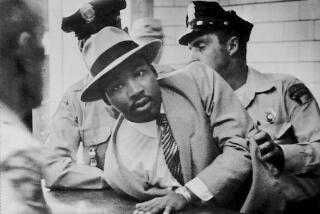NONFICTION : KING ARTHUR: HERO AND LEGEND by Richard Barber (St. Martin’s: $19.95; 216 pp., illustrated).
- Share via
What someone once called the Arthur Industry goes on, riddling its riddles, presenting myriad solutions, selling books. Unlike two other recent Camelotian exercises, Norma Lorne Goodrich’s philological “King Arthur” (Franklin Watts, 1986) and Geoffrey Ashe’s archeological “The Discovery of King Arthur” (Anchor/Doubleday, 1985), Richard Barber’s slim work isn’t theoretical but summary. More so than many summarizers, though, this British scholar--he edits the annual publication “Arthurian Literature”--spices up the usual procession of romances and evidences (of the elusive “real” Arthur) with generally solid perspective and occasionally pointy opinions.
Still, there isn’t enough to set this chronicle apart from its predecessors--and there certainly isn’t anything in it to justify the odd blurbs on the back dust cover: “Who was the real Arthur? . . . Was he buried at Glastonbury? . . . Barber answers these and many other questions. . . .” No he doesn’t. He couldn’t really, within the context of a sensible overview; the origins of the historical Arthur will probably always remain cloudy, because Celtic mythology was grafted onto most of the sketchy records of an actual 5th-Century Briton warrior-chief, or obscured him entirely.
No great loss that; the mythical Arthur and company are surely more fascinating than anything we might learn about another bloodletting brawler. From the 6th-Century “The Spoils of Annwfn” to Tennyson’s “Idylls of the King” and Eliot’s “The Wasteland,” the strange power of these legends has entranced millions. Barber, then, is more interesting when sorting through the early romances and the fiction, drama and poetry derived from them. Even here, there are gaps in his appraisal. Why, for instance, does he wonder what caused the flowering of Arthurian literature in the 19th Century--and skip so briskly past the answer: Sir Walter Scott’s mawkish but immensely popular reworkings. Barber’s haste is easier to forgive when one finds what he’s rushing toward: a sensitive analysis of Tennyson’s currently underrated treatments. Barber is also generally readable and authoritative, the illustrations are profuse (many in color) and well-selected, and this is as good a place as any for adult Arthurian novices to begin. Advanced students, however, can start unraveling the brilliant sense and misguided nonsense to be found in Goodrich, Ashe, Weston, Loomis, et al.
More to Read
Sign up for our Book Club newsletter
Get the latest news, events and more from the Los Angeles Times Book Club, and help us get L.A. reading and talking.
You may occasionally receive promotional content from the Los Angeles Times.






